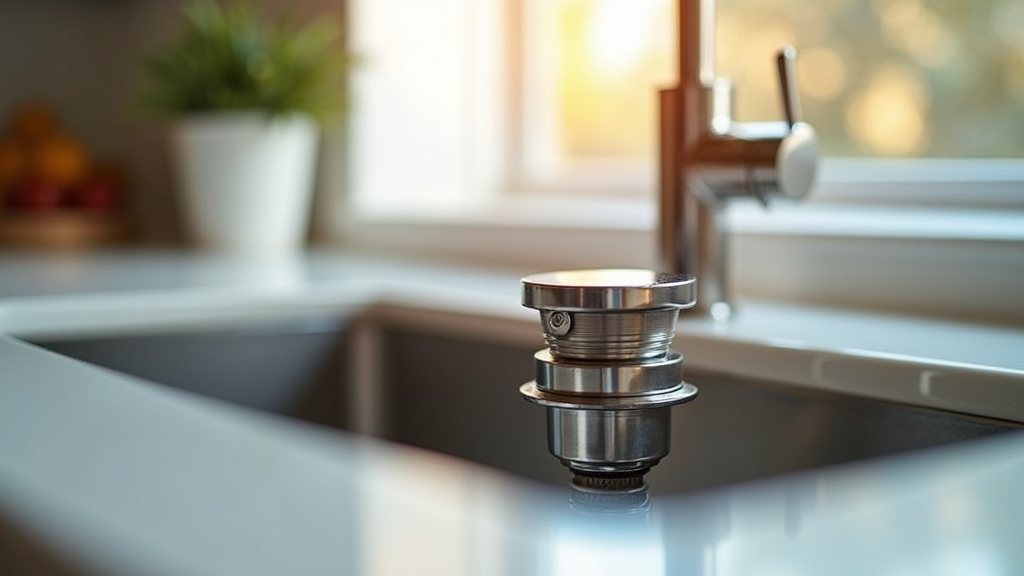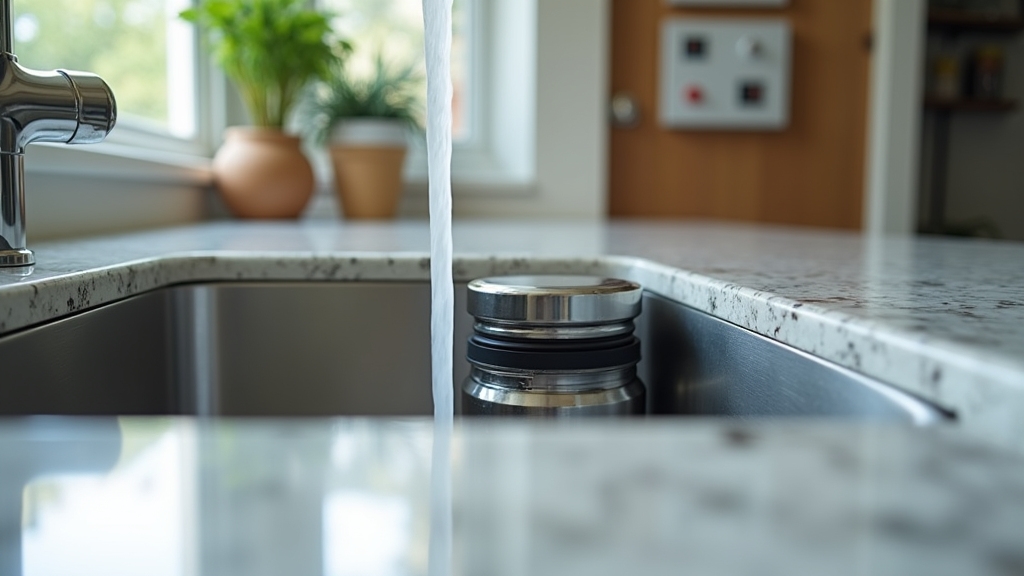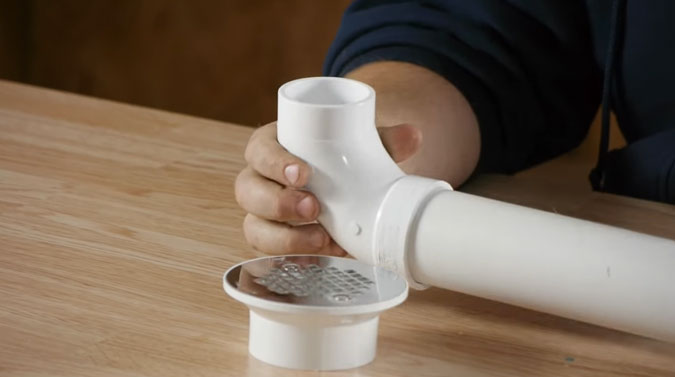You can use a garbage disposal with a septic system, but you need to limit food waste to small, soft scraps and avoid fibrous or greasy materials. Disposals increase solids, which can overload bacteria, raise sludge buildup, and reduce tank efficiency, requiring more frequent pumping and maintenance.
Using septic-safe disposals with microbial boosters helps protect your system. Understanding how disposals affect septic performance and proper upkeep can help you manage costs and extend system lifespan effectively.
Key Takeaways
- Garbage disposals increase solid waste volume, potentially overloading septic tanks and impairing bacterial digestion.
- Using a disposal with a septic system requires more frequent pumping, typically every 1–3 years instead of 3–5.
- Avoid disposing fibrous, starchy, fatty, or tough food waste to prevent clogs and septic system damage.
- Specialized septic-safe disposals with microbial additives can help maintain bacterial balance and reduce system stress.
- Regular septic inspections and maintenance are essential to prevent backups and extend system lifespan when using a disposal.
How Garbage Disposals Interact With Septic Systems?
Although garbage disposals effectively grind food scraps into small particles for flushing, they markedly influence septic system performance by increasing the volume of solid waste entering the septic tank.
When you use a disposal, these finely shredded particles flow with wastewater into the septic tank, raising the total solids load. This increased input challenges the tank’s bacterial digestion capacity and reduces the available volume for settling and treatment.
Continuous food disposal can overwhelm the bacteria responsible for breaking down wastewater solids, reducing their ability to treat the wastewater effectively.
Not all food scraps are equally suitable; fibrous or starchy materials can clog or jam the disposal, complicating waste processing. Moreover, improper disposal habits, such as introducing fats, oils, and grease, can cause clogs and damage within the septic system.
While disposals offer a convenient alternative to landfill disposal by processing food at the sink, you must recognize that they alter the quantity and characteristics of solids introduced. This directly affects the septic system’s operational dynamics and maintenance demands.
Effects of Garbage Disposal Use on Septic Tank Performance
When you use a garbage disposal with a septic system, it considerably increases the solids entering the tank, which impacts its overall performance. The added food waste elevates sludge accumulation, reducing tank capacity and necessitating more frequent pumping.
Pump-outs are costly and inconvenient, adding to maintenance burdens. Improper maintenance can lead to valve wear and tear, accelerating system degradation.
This excess organic matter disrupts the septic tank’s bacterial ecosystem, impairing microbial decomposition efficiency and causing slower waste breakdown. Higher solids and water volumes overload the tank, decreasing retention time and raising the risk of solids migrating to the drainfield.
Solids entering the drainfield can clog soil pores, thicken biomats, and ultimately degrade drainfield function. This degradation increases environmental contamination risks.
Consequently, system wear accelerates, maintenance frequency and costs rise, and overall septic system effectiveness declines. These issues can lead to backups, premature repairs, and costly replacements.
Septic-Safe Garbage Disposal Options and Technologies

Managing the challenges posed by traditional garbage disposals in septic systems has led to the development of specialized septic-safe disposal options and technologies. Innovations in septic-safe disposals address traditional system challenges with advanced waste management technologies.
You can choose disposals with smaller motors (1/3 to 3/4 HP) that minimize grinding heavy solids, reducing septic strain. These disposals often feature adjustable float switches to optimize pump activation and protect the septic system.
Systems like Sepura divert solid scraps into sealed compost bins under the sink, preventing solids from entering the septic tank. Sepura also reduces pumping needs by up to 50% by stopping food from draining into the septic system.
The InSinkErator Evolution Septic Guard integrates a microbial injection system (BOOST™) that enhances food waste breakdown within the septic system. These technologies reduce sludge accumulation and extend pumping intervals.
Additionally, noise insulation improves user experience without compromising septic function. Many models labeled “septic safe” offer continuous feed operation and are widely available, combining operational efficiency with environmental benefits by lowering organic waste impact on septic health.
Types of Food Waste Suitable for Septic System Disposal
Selecting the right types of food waste for disposal in a septic system is essential to maintaining its efficiency and longevity.
You should focus on biodegradable, soft, and easily grindable scraps while avoiding fibrous, fatty, or expanding foods. Choosing the appropriate materials helps prevent damage to the system’s delicate components, such as chlorine-resistant tubing.
Small quantities of cooked, low-fat food waste and soft fruit or vegetable scraps promote better bacterial digestion and prevent system overload. It is important to use disposals sparingly to avoid overloading the septic tank.
| Food Waste Type | Suitability | Notes |
|---|---|---|
| Soft fruit peels | Suitable | E.g., banana, melon; easy to degrade |
| Small cooked vegetables | Suitable | Minced, low-fat; small amounts only |
| Dairy & eggshells | Limited use | Minimal dairy; avoid eggshells |
| Fibrous/tough materials | Unsuitable | Avoid corn husks, celery, nuts |
Foods and Materials to Avoid With Garbage Disposals on Septic
Because septic systems rely on natural bacterial processes to break down waste, disposing of certain foods and materials through garbage disposals can severely disrupt their function. Avoid fruit pits, peels, tough skins, and fibrous vegetables like celery or onion skins, as they resist decomposition and cause blockages.
Potato peels and hard seafood shells similarly accumulate and obstruct flow. Eggs and coffee grounds compact into dense masses, increasing sludge buildup and pumping frequency.
Additionally, coffee grounds can accumulate and cause blockages in drains, which further impair septic system performance. Starchy foods such as pasta and rice swell, forming clogs in pipes and drainfields. Fats, oils, and grease congeal, blocking wastewater flow and risking system failure.
Non-food items, hard bones, nuts, seeds, and fibrous parts also damage disposal blades and septic components. Proper exclusion of these materials preserves septic efficiency and reduces maintenance needs.
Financial Implications of Using Garbage Disposals With Septic Tanks
When you use a garbage disposal with your septic tank, expect increased pumping frequency and higher maintenance costs due to added solids and organic waste.
This buildup accelerates sludge accumulation, requiring more frequent professional services that can raise your expenses considerably. Proper maintenance includes draining the water from the system to avoid damage. Over time, these factors contribute to long-term maintenance challenges.
They may also lead to potential costly repairs. Regular pumping every 3 to 5 years is recommended to prevent solids buildup and clogs, especially when a garbage disposal is in use, to avoid costly repairs.
Increased Pumping Costs
Adding a garbage disposal to your home considerably increases the volume of solid waste entering your septic tank. This accelerates sludge buildup and forces more frequent pumping—often every 1 to 3 years instead of the usual 3 to 5.
This increase in pumping frequency directly raises your maintenance costs due to more labor, disposal fees, and service calls. The denser solids require extra time to pump out, which pushes fees higher.
Costs can be especially elevated in regions with higher labor rates or disposal fees. Regional variations play a significant role in how much more you might pay. Regular maintenance, including checking for clogged filters, is essential to prevent system issues caused by increased solid waste.
| Factor | Impact on Pumping Costs |
|---|---|
| Increased sludge volume | More frequent pumping needed |
| Denser solids | Higher labor and disposal fees |
| Regional variations | Elevated costs in some areas |
Long-Term Maintenance Expenses
Though garbage disposals offer convenience, they considerably increase the long-term maintenance expenses of septic systems by accelerating wear and necessitating frequent repairs. The added solids and grease overload your septic tank, causing baffle damage and clogging drain fields.
These problems can require costly repairs or replacements, ranging from hundreds to thousands of dollars. Filters demand more frequent cleaning, typically costing $100 to $400 per service. Additionally, clogged pipes may need hydro-jetting, which raises labor expenses.
Such issues shorten your system’s lifespan, potentially forcing a full replacement. This can cost anywhere from $3,000 to $15,000 or more. You’ll also face increased monitoring and inspection costs, which run around $250 to $500 per visit. Regular inspections are essential to ensure components function effectively and catch problems before they escalate.
Best Practices for Maintaining Septic Systems With Garbage Disposals
Because garbage disposals increase the solids entering your septic tank, you must adopt specific maintenance practices to preserve system efficiency. Limit disposal use to small food waste amounts and avoid fats, greases, fibrous, or starchy items that septic bacteria struggle to digest.
Garbage disposals offer a convenient alternative to trash cans and help divert food waste from landfills, but only if used correctly with a septic system convenient alternative. Selecting the right equipment with appropriate motor protection can further reduce system strain.
Schedule regular septic inspections to monitor sludge accumulation and bacterial health. Increase pumping frequency to prevent backups caused by excess solids; expect costs to rise accordingly.
Use disposals with septic-safe technologies, such as bacterial inoculants or injection systems, to enhance organic matter breakdown. Avoid flushing chemicals or non-biodegradable materials that disrupt bacterial activity.
Maintain plumbing integrity to prevent clogs from partially processed waste. These practices help sustain bacterial balance, reduce system overload, and extend septic tank lifespan despite the additional burden from garbage disposal use.
Frequently Asked Questions
Can Using a Garbage Disposal Void My Septic System Warranty?
Yes, using a garbage disposal can void your septic system warranty if the warranty explicitly excludes damage caused by disposals. You should check your warranty terms carefully, as many manufacturers consider disposal use improper, leading to denied claims.
To avoid this, notify your provider before installation and consider septic-safe disposals that minimize solids buildup. Regular maintenance and approved equipment help maintain warranty coverage and prevent costly disputes.
Are There Specific Brands of Disposals Recommended for Septic Systems?
Yes, you should consider brands like InSinkErator and Sepura for septic systems. InSinkErator’s Evolution Septic Guard features BOOST™ Injection System, which injects bacteria and enzymes to aid waste digestion and diminish odors.
Sepura disposals divert solids to a compost bin, preventing septic overload. Both integrate with existing plumbing, support septic health, and reduce sludge buildup. Selecting these guarantees efficient waste management without compromising your septic system.
How Does Water Usage Change When Using a Garbage Disposal With Septic?
When you use a garbage disposal, your water usage increases considerably because you need more water to flush food particles through the plumbing. This added volume can overwhelm your septic tank, reducing the time solids settle and disrupting bacterial breakdown.
To protect your septic system, you should control water flow, avoid excessive rinsing, and fix leaks promptly. Managing water volume is essential to maintain system efficiency and prevent overloading.
Can Garbage Disposals Cause Odors in Septic Systems?
Garbage disposals can indeed cause odors in septic systems—after all, “too many cooks spoil the broth.” When food waste overloads your septic tank, it disrupts bacterial balance, slowing decomposition and producing foul gases like methane.
These gases escape if vents clog or traps dry out, filling your home with unpleasant smells. Regular pumping, vent maintenance, and careful disposal reduce this risk, keeping your septic system odor-free and functioning efficiently.
Is It Safe to Install a Garbage Disposal on an Older Septic System?
It’s generally not safe to install a garbage disposal on an older septic system without precautions. You risk clogging, backups, and accelerated sludge buildup because older systems can’t efficiently process increased organic solids.
If you must use one, limit disposal to easily degradable waste, increase pumping frequency, and consider septic-safe disposals with enzyme injection. Regular inspections will help detect issues early, preventing costly repairs and preserving system function.
Septic-Safe Garbage Disposals: A Smarter Choice
You can use a garbage disposal with a septic system, but you need to be cautious. Studies show that food waste can increase the solids in your septic tank by up to 50%, accelerating sludge buildup and requiring more frequent pumping.
Choosing septic-safe disposals and avoiding grease or fibrous foods reduces this impact. Regular maintenance and mindful disposal habits help keep your system efficient, protecting both your plumbing and the environment over time.


